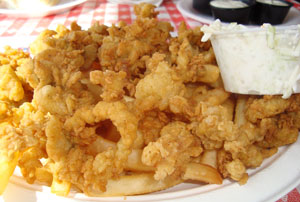Clams Ahoy!
Everything you always wanted to know about Clams but were afraid to ask!!
Fried Clams
The Best Fried Clams
Fried clams are unusual seafood because they’re served daily all across the US, even in areas far from the ocean. They’re believed to have been invented sometime during the 1930s in New England, and their popularity grew with the expansion of the Interstate Highway system and the Howard Johnson’s restaurant chain.
“HoJo’s” opened its first location in Quincy, Massachusetts in 1925, and was the first to serve “Tendersweet Fried Clam Strips” to a national audience at its one thousand Howard Johnson’s restaurants, now sadly reduced to three. The strips were cut from hard-shell Ipswich, Massachusetts clams. The second Howard Johnson’s location was on Cape Cod. Johnson invented the modern concept of restaurant franchising through an agreement that allowed its second location to use the HoJo’s brand, in exchange for purchasing all its stock and supplies from the original. Friendly’s is another New England-based restaurant chain that serves fried clams far from where the clams themselves are harvested. Except that some fried clams are not clams at all. We’ll get to that in a second.
 Although
they’re served at fine restaurants, fried clams are best known as a roadside
treat served in white cardboard containers, pints and quarts. Unlike French
fries, they can be expensive. A pint of fried clams may sell for as much as
$25 at “the Weatherdeck” or “Aunt Mary’s,” two seafood family restaurants
famous in Massachusetts and Rhode Island respectively. The most important
basis for deciding where to eat roadside fried clams is the smell outside.
If it is unpleasant, rancid (from deep fry oil not changed often enough) or
smells too much of onion, choose another restaurant. Good fried seafood
relies on commercial fry fat changed at least once a day, more often if
volume is high. A well-known brand of commercial deep fry fat is FryMax.
Increased parental interest in how served food is prepared has created more
options for those who want lower levels of saturated and unsaturated fats.
Captain Frosty’s, in Dennis MA fries only with canola oil. Other oils will
also get the job done. In general, the healthiest frying oil is liquid at
room temperature.
Although
they’re served at fine restaurants, fried clams are best known as a roadside
treat served in white cardboard containers, pints and quarts. Unlike French
fries, they can be expensive. A pint of fried clams may sell for as much as
$25 at “the Weatherdeck” or “Aunt Mary’s,” two seafood family restaurants
famous in Massachusetts and Rhode Island respectively. The most important
basis for deciding where to eat roadside fried clams is the smell outside.
If it is unpleasant, rancid (from deep fry oil not changed often enough) or
smells too much of onion, choose another restaurant. Good fried seafood
relies on commercial fry fat changed at least once a day, more often if
volume is high. A well-known brand of commercial deep fry fat is FryMax.
Increased parental interest in how served food is prepared has created more
options for those who want lower levels of saturated and unsaturated fats.
Captain Frosty’s, in Dennis MA fries only with canola oil. Other oils will
also get the job done. In general, the healthiest frying oil is liquid at
room temperature.
Real fried clams are listed just that way on the menu: “fried clams.” For dilettantes and other dainty persons, “clam bellies” and “clam necks” are sometimes on offer. The clam belly is the main body of the clam. Clam necks are known as siphons in clam biology. Many people prefer clam necks, synonymous with “clam strips.” Their standardized shape, however allows for fraud, and this is often how fried “clams” are served thousands of miles from ocean waters: inexpensive frozen meats but not clam meats. The Atlantic seaboard and other areas where hard- and soft-shelled clams are available is also home to the channeled whelk or “conch” (pronounced “conk” in the Caribbean, “conch” everywhere else). A visitor to a Cape Cod town landing may see hundreds of whelks dumped from traps at one time. Conchs are predators and in fact consume clams, mussels and other invertebrates. But unlike clams, conch meat is extremely tough, too chewy for most people to swallow no matter how long work at it. Our own attempts to first pulverize (with a hammer), then marinate conch meats into submission made no difference! The meat was flavorful, but still impossible to swallow. Nonetheless the “fried clams” you purchase from a restaurant in Grand Rapids, Michigan may be slices of carved, tenderized conch meat. Real fried clams include the entire body of the clam.
Conch or clam, you fry each the same: roll the cleaned flesh in a battered coating – corn flakes is an interesting variation to add to the batter – then deep fry until golden brown. Serve after 3-4 minutes to avoid burns, and serve with tartar sauce. No other sauce will do!
Also take a look at our brief guide to The Best Fried Clams.
 Hi,
we are Ted and John, just two guys who love Clams and other seafood.
Hi,
we are Ted and John, just two guys who love Clams and other seafood.